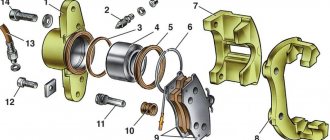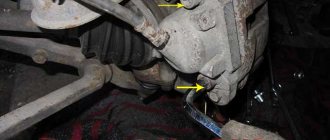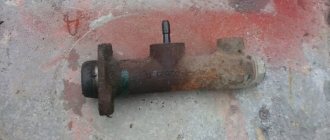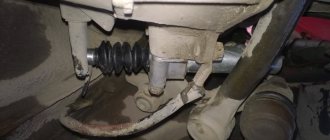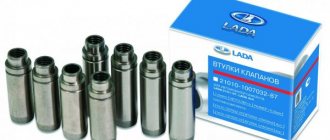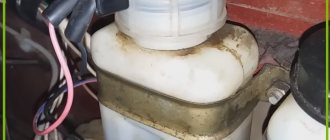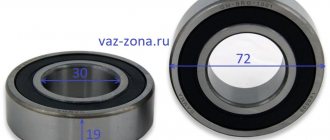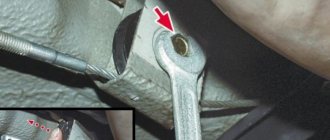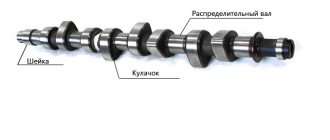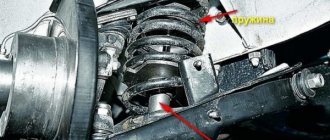Replacing the rear brake cylinder on a VAZ 2101-2107
If the rear brake cylinder on a VAZ 2101-2107 begins to jam or perform its function ineffectively, it should be replaced with a new one. To do this we need the following tool:
- Split wrench for unscrewing brake pipes
- Penetrating lubricant
- 10mm socket with ratchet or regular 10mm wrench
So, the first step is to perform some preparatory procedures, which are listed below:
After this, the rear brake cylinder becomes free and its location is shown in the photo below:
So, first you need to spray the brake pipe with penetrating lubricant, and then unscrew it:
After this, you need to unscrew the two bolts securing the cylinder, which are located on the reverse side:
The most convenient way to do this is with a socket and ratchet:
And now you can safely remove the VAZ 2101-2107 brake cylinder from the reverse side, as is clearly demonstrated in the photo below:
Next, we buy a new cylinder, the price of which for all classic models is about 300 rubles apiece. If you change a pair, you will have to buy two pieces and spend 600 rubles. Installation is carried out in reverse order.
If necessary, after replacement, bleed the brakes if there is air in the system.
zarulemvaz.ru
If you notice a brake fluid leak that appears on the inside of the rear wheels in the form of smudges, most likely the problem lies in the brake cylinder and it should be replaced. The reason could be a simple damage to the rubber cuffs. When sealing the brake pistons, a complete replacement of the brake cylinder is also required. Prepare a brake pipe wrench and new brake fluid. Ensure that your partner helps you.
To begin, slightly raise the car using a jack. On the side to be repaired, remove the wheel and brake drum to give yourself full access to the brake cylinder.
Cylinder replacement
- After the brake drum is removed, take some gasoline and wash the internal cavity to remove dirt and dust.
- After this, take a special wrench and unscrew the tube mounting fitting on the back of the brake flap. Plug the freed hole with a plug or any other plug, otherwise the brake fluid will leak out completely. If the fitting cannot be unscrewed, and it is stuck very firmly, then you will have to break it and subsequently replace the brake pipe with a new part.
- Then unscrew the two mounting bolts of the brake cylinder itself.
- Disengage the cylinder from the pads and remove it.
During the repair process, check the condition and quality of the rubber cuffs. As practice shows, replacing the cuffs has virtually no effect - brake fluid leaks do not stop. Therefore, if the cuffs are damaged, it is better to completely replace the mechanism with a new cylinder. Inspect the thickness of the brake pads. If necessary, replace them as well. It should be remembered that the pads should be replaced immediately in pairs for each side. All parts should be assembled in the reverse order of dismantling.
Rem-Vaz.ru
Replacing the rear wheel brake cylinder
EXECUTION ORDER
Removing the brake drum
Using a screwdriver, we remove first one, then the other, lower parts of the brake pads from the support and move the pads down.
Using a “10” wrench (or a special “brake” wrench), unscrew the brake pipe fitting. To avoid loss of brake fluid, place a protective cap from the bleeder fitting on the end of the tube.
Using a 10mm socket, unscrew the two bolts securing the cylinder to the brake shield...
...and remove the cylinder. Install the cylinder in the reverse order of removal. After assembly (including installation of the brake drum), we bleed the brake system from the side of the replaced cylinder.
avtolyubiteli.com
We replace the working brake cylinder of the rear wheel of a VAZ 2107 car when a brake fluid leak is detected or the pistons are jammed. To perform the work of replacing the working brake cylinder of a VAZ 2107 car, you will need an assistant, as well as a special 10 mm wrench for brake pipes, a transparent vinyl tube of suitable diameter, a container for draining brake fluid, fresh brake fluid (see “Operating fluids used on VAZ cars 2107").
Removing the rear wheel brake wheel cylinder from a VAZ 2107 1. Prepare the VAZ 2107 for operations (see “Preparing the VAZ 2107 for maintenance and repair”). 2. Remove the brake drum from the VAZ 2107 car (see “Brake pads for the rear wheels of the VAZ 2107 car - replacement”). 3. We clean the bolts securing the working brake cylinder and the brake pipe fitting from dirt. We apply a penetrating lubricant with a rust converter to them.
Attention If the fitting is “stuck” to the tube and you cannot unscrew it, try (after performing step 6) to unscrew the working brake cylinder, holding the fitting with a special 10 mm wrench for brake pipes. With this method of removing the brake wheel cylinder, the brake pipe must be replaced.
5. To reduce brake fluid losses, place a protective cap on the end of the tube (from the brake cylinder bleeder fitting). 6. Using a 10 mm socket wrench, unscrew the two bolts securing the working brake cylinder and remove the working brake cylinder from the VAZ 2107 car.
8. Remove the rear wheel brake slave cylinder from the brake shield.
Installing the rear wheel brake wheel cylinder on a VAZ 2107 car 1. Install the brake wheel cylinder on a VAZ 2107 car in the reverse order.
Attention When installing the brake wheel cylinder stops into the pads, do not damage the rubber protective boots of the brake cylinder.
3. Before fixing the working brake cylinder with bolts to the brake shield, screw the tube fitting into the brake cylinder by hand. 4. We finally wrap the fitting.
.
vazikov.ru
Tuning of domestic cars usually ends with changes in the external appearance of the car or interior trim. You can especially often find tuning of a VAZ 2107 car. Tuning includes many different changes and additions, starting with the car's LED lighting and ending with an automatic engine start button.
You can replace all the factory light bulbs, install comfortable seats, install a new steering wheel, etc., but all this is done for the sake of comfort and standing out from the crowd. However, serious car enthusiasts must first think about the safety of their car.
dismantling the brake mechanism of the front wheel of a VAZ 2107
| The brake mechanism of the front wheel of a VAZ 2107 car consists of a brake caliper, brake wheel cylinders, a brake disc and brake pads. We remove the brake caliper of the front brake mechanism from the VAZ 2107 to replace it, replace the working cylinder or brake disc. The work is shown using the example of the brake mechanism of the right wheel of a VAZ 2107 car. To disassemble the brake mechanism of a VAZ 2107 car, you will need an assistant, as well as a special 10 mm wrench for brake pipes, a transparent vinyl tube of a suitable diameter, a container for draining brake fluid, fresh brake liquid (see “Operating fluids used on VAZ 2107 vehicles”). |
Removing the front wheel brake mechanism from a VAZ 2107 car
1. We prepare the VAZ 2107 car for operations (see “Preparation of the VAZ 2107 car for maintenance and repair”). 2. Remove the front wheel from the VAZ 2107 (see “Wheel of the VAZ 2107 - replacement”). 3. Remove the brake pads of the front wheel brake mechanism (see “Brake pads of the front wheels of the VAZ 2107 car - replacement”). 4. Disconnect the front wheel brake hose from the brake caliper (see “Front wheel brake hose of a VAZ 2107 - replacement”). 5. Using a chisel, bend the locking plate of the lower brake caliper mounting bolt (the lower brake caliper mounting bolt differs from the upper brake caliper mounting bolt in the presence of a spherical part). 6. Using a 17 mm socket wrench with an extension, unscrew the bolt of the lower brake caliper mounting. 7. Remove the brake caliper bolt along with the locking plate. 8. Similarly, unscrew the upper mounting bolt and remove the brake caliper assembly with the working brake cylinders from the VAZ 2107 car. The working brake cylinder of a VAZ 2107 must be replaced if the piston is jammed or if brake fluid leaks through the sealing ring. 9. Secure the brake caliper in a vice. 10. Using a 10 mm wrench, unscrew the two fittings securing the connecting tube of the working brake cylinders. 11. Remove the brake pipe. 12. Using a drift, press the spring-loaded clamp, while simultaneously knocking the brake cylinder out of the brake caliper along the guides.
Attention The brake cylinders of the front wheels of the VAZ 2107 are not interchangeable. Do not mix up the brake cylinders during installation.
2. Before installing a new brake cylinder, press the latch and install the brake cylinder into the guide grooves of the brake caliper.
Attention If it is difficult to install the new brake cylinder into the brake caliper, use a file to blunt the leading edge of the brake cylinder installation guide.
3. Press in the brake cylinder until the latch engages. 4. Replace the copper sealing washers with new ones (see “Brake hose of the front wheel of a VAZ 2107 car - replacement”). 5. After installing the brake caliper on the VAZ 2107 car and connecting the brake hose, pump the brakes from the side of the replaced brake cylinder (see “Hydraulic brake drive of the VAZ 2107 car - pumping and replacing brake fluid”).
Attention We replace brake discs in pairs on both sides of the VAZ 2107. Periodically check the condition of the brake discs (see “Brake system of the VAZ 2107 - checking technical condition”) and replace the brake discs when worn, avoiding wear of the brake discs to a thickness of less than 9.5 mm , with increased lateral runout or in case of deep marks on the working surface.
Brake system VAZ 2107
It's no secret that the safety systems provided for the VAZ 2107 have not undergone significant improvements since the first production of the car. There are no airbags or related electronics in such a car. Once you get your hands on such a car, the first thing you need to do is check the brakes. In fact, a car's safety systems are based on the car's braking performance.
Crash test
As crash tests of domestic cars show, it makes no sense to rely on the car body itself. A frontal or side collision with an obstacle already at a speed of 64 km/h will turn the “seven” into an accordion.
Thus, there is no space left for the driver or passengers. Despite all the “unsafety”, the VAZ 2107 is very popular among car owners. Fortunately, it is now not difficult to find spare parts for tuning domestically produced cars and you can modernize your car without any problems.
The pistons of the brake cylinders are jammed, what should I do?
Welcome! Brake cylinders - thanks to them, braking is carried out, and without the pistons that are in them, these cylinders will not work at all, so if a piston fails, then you have to go to a car store and buy a new brake cylinder, because driving without brakes is scary and even more dangerous , but not in all cases the pistons stop working forever, sometimes they can be revived, and we will write in detail about how to do this in this article.
Note! To work, you will need to stock up on: A jack to lift any side of the car, as well as a wheel wrench and you may also have to stock up on bricks, and you may also need a basic set of wrenches and sockets!
Summary:
How to understand that the pistons of the brake cylinder are not working? Let us answer this question before we move on to the repair of pistons, namely inoperative (That is, the pistons do not move in the cylinder), the pistons are recognized if they do not move at all and stand in one place, as a result of which the car, namely the brakes, begins a number of problems occur, that is, the car cannot drive normally because it constantly slows down even though you don’t press the brake pedal at all, or it may be that the car will drive but it will brake much worse than it should, in general, let’s figure it out Why do these cylinder pistons fail?
From time to time, the sealing ring (indicated in the photo below by an arrow) that fits the piston in a circle either wears out, or micro cracks form in it through which dirt begins to get into the piston itself, where the lubricant is located, and as a result the piston becomes unusable.
And also, the piston can simply sour in the brake caliper, and this can happen because of our roads, which in winter are mostly sprinkled with sand and salt, and the brake system is located in the very bottom of the car and therefore is subject to heavy braking. and in general, when moving, all this salt flies which little by little brings the situation to the point where the piston simply rusts, otherwise it simply sours, and therefore it will then be very difficult to move it from its place and thus it stops moving and therefore stops working.
The device of the "seven" brake mechanism
The system is designed for smooth or emergency stopping. As we have already determined, it is the main security system, and operation of the car is prohibited even if the slightest malfunction is detected.
In a classic braking system, the pedal is mounted on the same axis as the clutch pedal and is equipped with a return spring. This mechanism has a built-in sensor for turning on the rear brake light lamps.
Next comes the brake master cylinder. It is attached to the body in the engine compartment with two bolts and has working braking circuits for the front and rear wheels.
Now you can find vacuum boosters to reduce the effort applied to the pedal. The drive of such an amplifier is a fitting . It is mounted in the intake manifold, connected by a rubberized pipe. For reliability purposes, the front circuit has two fittings per wheel, and the rear circuit has one fitting.
Piston disc brakes are used on the front wheels. They are installed for greater braking efficiency, since a greater load is placed on the front wheels than on the rear ones.
The rear wheels are equipped with drum brakes. Structurally, they are much simpler than disk ones. As is known, their efficiency is extremely low, but is quite sufficient for rear-wheel drive vehicles. In addition, it is not profitable for the manufacturer to install more expensive disk mechanisms. A parking brake mechanism is also built into the rear wheel brakes.
An important mechanism of the system is hidden under the bottom of the car in the rear - this is the pressure drop regulator in the system. This mechanism distributes the pressure that is created during braking between the front and rear circuits.
Caliper: dismantling and installing the unit on a VAZ 2107
The front wheels of the “Seven” are equipped with disc brakes that are highly efficient.
Each of the components of the VAZ 2107 car has two working cylinders, which bring the pads together and clamp the part located between them. This causes the disk to stop rotating. During operation, parts wear out and the faulty caliper needs to be replaced with a new one. Typically, the cause of unit failure is corrosion processes of the cylinder walls and piston. In a working mechanism, they are protected from moisture by special rubber cuffs. Damage to these elements leads to moisture getting inside; over time, the unit loses its mobility and requires replacement or qualified repairs. Restoring the brake mechanism can be done independently.
Basic faults
The brake system itself is quite simple, but some of its elements require special attention. Main types of faults:
- The brake fluid leaks, resulting in a drop in pressure in the system. If a preliminary inspection does not find a leak, it is necessary to check the brake master cylinder. We bend the noise-insulating mat located under the brake pedal and inspect for streaks in the area of the rubber seal of the master cylinder. The presence of drips will indicate that the cause has been found and requires disassembling the cylinder and then replacing the cuff. If there is a vacuum booster, the brake master cylinder must be removed and inspected.
- When you release the brake pedal, the car drives sluggishly. Reason: the rear or front pads are jammed. Seized pads are identified by checking the heat of the corresponding wheel. We touch each disk - the hottest one will be jammed. In the case when these are the front wheels, you can, after removing the wheel, move the brake cylinder. If this fails, you will have to replace it with a new one. In the case of rear pads, the brake wheel cylinder will need to be replaced.
- When you press the pedal, braking does not occur, but it does when you press it several times in a row. This may indicate the presence of air in the system. The solution to the problem is to bleed the brakes to remove air.
- Problem with the handbrake. Most often this problem occurs in winter. It manifests itself in the fact that after a long period of parking, when the handbrake is released, the wheels remain locked. The reason is that the parking brake cable is frozen. During its operation, moisture gets there and freezes in winter. If the casing is severely damaged, it will have to be replaced.
Required Tools
After pumping, carefully check the new cylinder and its connection to the pipe for leaks. To do this, press and hold the brake pedal as hard as possible several times.
- To make your job easier if the new cylinder you purchased breaks, so as not to do the job wrong. You can check the cylinder without a drum, but here you need good physical strength and two mats to compress and hold the pistons.
- When the brakes are adjusted properly, the front wheels engage the pedal first because they are closest to the master cylinder, and then both rear wheels engage simultaneously. If this is not the case, pump out the system or send it back to the service center.
- However, sometimes it is possible to repair the rear brake cylinder; for this purpose, repair kits are sold, which include several o-rings and two injectors. But this is only desirable if its inner surface is in perfect condition.
Replacing brake discs yourself
Replacing front discs
Replacing brake discs is necessary when its thickness is less than 9.5-11 millimeters. When the pads wear out, the pistons can come out of their seats and create misalignment. The second reason for replacement may be uneven wear and deep risks .
Such problems increase brake pad wear and reduce braking performance. In these cases, the disks must be replaced. Their timely replacement is the key to your safety.
Remove the wheel and caliper with brake pads. To do this, unscrew the two guide pins.
Next, remove the intermediate ring and the worn disc.
After this, the new disk is installed in the reverse order.
Replacing rear drums
Replacing the rear brake drum is more difficult than the front one, but it is quite doable on your own.
For this replacement, we also remove the wheel and unscrew the two guide pins.
Sometimes the drum gets stuck to the seat. Removing it becomes problematic. When removing, part of the side may break off. To disrupt it, there is the following method: start the engine, then engage first gear and, pressing the brakes, release the clutch. The disk breaks off.
Severe wear of the rubbing surface by the pads also complicates everything. To remove it, take a wooden block and a hammer. Without striking too hard, the drum should come off.
We remove it as soon as it starts to go away.
We inspect the brake drum and if there is serious damage, replace it with a new one.
In conclusion, it should be noted that it is enough to carry out regular checks and timely repairs of the entire brake system and you will not need to worry about the reliability and safety of your car.
The brake system on any car plays an important role, which is the safety of the driver and passengers. In this article, we will look at one of the mechanisms of this system - the front (working) brake cylinder, which provides braking to the front wheels when the brake pedal is pressed.
The product in question, or more precisely, the brake cylinder on a VAZ-2107 car, periodically wears out and becomes inoperative, just like many other parts. A faulty mechanism can cause an emergency on the road, so to prevent this from happening, the performance of this product should be periodically monitored. In this material we will find out where it is located, as well as the features of its replacement for the VAZ-2107 car.
Installing the brake mechanism and bleeding the system
The restored caliper of a VAZ 2107 car is put on the disc and secured with bolts to the steering knuckle. The pads are inserted into the gap and fixed with guide springs; if necessary, parts are replaced with new ones. The brake hose and tube are installed in place, and the system is filled with fluid to the specified level. Repair of the brake mechanism ends with bleeding to remove it from the system.
This process on a VAZ 2107 car is carried out as follows: a hose of a suitable diameter is put on the nipple of the working cylinder. Its other end is lowered into a container with liquid. The assistant sits behind the wheel and presses the brake pedal several times and holds it in that position. Using the key, release the nipple and let out the air. We repeat this action until bubbles stop appearing in the container.
Front cylinder location
The front brake cylinder is located on the front wheel hubs, next to the wheel rim. Each front wheel has two brake devices, which, when you press the pedal, press the pads against the brake disc on both sides, which ensures effective braking of the car. For clarity, below is a photo in which both devices are indicated by arrows.
After removing the front wheel of the seven, you can see the device data immediately behind it. Having found them, you need to make sure that they are in good working order, or rather, that they are faulty. After all, why change a working part?
When to change cylinders
The main and most common reason for loss of performance, which entails repair or replacement, is jamming of the brake device. If you notice constant braking of the car, a pull to the side when you release the steering wheel when driving in a straight line, or abnormal heating of one of the wheels after driving, perhaps one of the working cylinders has begun to jam. This happens quite often, since aggressive and improper operation, as well as the quality of parts, leads to such consequences. Jamming of the product can occur in any mode of operation - be it constant driving of the car, or its idle time in the parking lot. If at least one of the cylinders on the VAZ-2107 begins to jam, then you should immediately get to the nearest service station and have it repaired. But a service station is expensive, especially for owners of budget cars, so it’s easier to solve the problem yourself, and at home.
Replacement of the product may also be necessary if liquid begins to leak from under the sealing ring. The sealing ring (boot) is shown below in the photo.
If liquid begins to leak from under the rubber band, it means that this will soon lead to a malfunction of the device. You can avoid consequences by responding in a timely manner.
Replacing the front brake cylinder on a VAZ-2107
Replacement begins directly with the removal of the old mechanism. To do this, you need to jack up the front of the car, then unscrew and remove the wheel, and remove the brake caliper. Details of caliper removal can be found in the corresponding section of this website.
Further actions to replace the working mechanism should be carried out as follows:
- The caliper should be placed in a vice, but it is important not to clamp it too tightly. If you squeeze it, then part of the part may simply break off, as a result, replacing the caliper cannot be avoided.
- Once the caliper is removed and clamped in a vice, it is necessary to remove the steel brake pipe. This tube connects both parts of the mechanism. To remove the tube, you need to unscrew two nuts with a wrench. After unscrewing the nuts, you can remove the steel tube. The photo below shows the caliper in a vice, as well as the tube that needs to be removed.
- After this, you need to find a groove on the side in which the spring locking element is located. To remove the brake cylinder, you will need to press this lock with a screwdriver. The photo below shows the location of the groove with a red arrow.
- To remove the working device, you need to hold the spring mechanism with a screwdriver. After pressing the latch, it is necessary to strike the side of the working mechanism with a rubber hammer. You don’t need to hit it too hard, but be sure not to hit the caliper. If you hit the caliper, it may break off. The photo above shows how the working cylinder is struck with a hammer.
- If the product starts to move, then the process is in progress. To dismantle the part in question, you will need to use a long screwdriver or pry bar. The mount should be placed in the resulting hole between the caliper and the cylinder. Below is a photo of how it looks clearly.
- The second cylinder is removed in a similar way. After removing the devices, you can begin to directly replace them with new ones.
- To install a new product in place of a removed one, you must first press a special latch. When pressed, the mechanism must be installed in the guide grooves until this latch is activated.
If the new part will not be inserted into the guide grooves, you can take a file and remove a few millimeters of the metal layer. The main thing is not to overdo it, otherwise the part simply will not be fixed in the caliper.
This completes the replacement of the working cylinder on the VAZ-2107. When installing a new product, pay attention to the presence of a brake bleeder. If it is missing, then you should remove it from the old cylinder and screw it into the new device.
We are working on a jammed front brake piston 2108, 2109, 21099
The brake mechanisms (calipers) of the front wheels of VAZ 2108, 2109, 21099 vehicles operate under constant exposure to an external aggressive environment (salt, dirt, water, etc.). In this regard, it is recommended to inspect and service calipers and brake pads every 15 thousand km. Jamming or “souring” of the pistons in the caliper cylinders is most often the result of a lack of periodic monitoring of the condition of the brake mechanisms, damage to their protective boots, severe wear of the brake pads in which the pistons extend too far from the cylinders, thereby coming under external influence, the presence of water or foreign substances. impurities in brake fluid.
Reference: the pistons of the brake mechanisms of the front wheels of VAZ 2108, 2109, 21099 cars have a mirror coating, the same coating is found inside the cylinders. The cylinders are equipped with rubber rings that return the pistons to their original state after extension. On the outside, the pistons are protected by anthers (protective caps with retaining rings).
Damage to the mirror coating of the pistons (“souring”) leads to a loss of their mobility in the cylinders and, as a consequence, to incomplete release of the front wheels, since the pads are constantly pressed against the brake discs. In this case, accelerated wear of the pads, overheating and warping of the brake discs occurs, fuel consumption increases, the vehicle's controllability (pulls to the side) and its dynamics are impaired, vibration and beating appear when the brake pedal is pressed.
There are at least two ways to develop a soured piston:
— without removing the brake mechanism from the car;
- with the brake mechanism removed.
In the first case, it is necessary to jack up the car, remove the wheel, clean the outside of the caliper from dirt, disconnect and lift its floating bracket.
Installing the brake caliper
Installation of the brake caliper on the VAZ 2107 is carried out in the reverse order of its dismantling.
After installing the brake caliper, it is imperative to bleed the brake system, removing air from it. Until this operation is completed, operating the vehicle is strictly prohibited.
The left and right wheel calipers are slightly different, so you need to pay attention to this when purchasing new ones.
After repairing and installing the VAZ 2107 brake caliper, it is necessary to check the brake system for fluid leaks and, if necessary, repair them.
